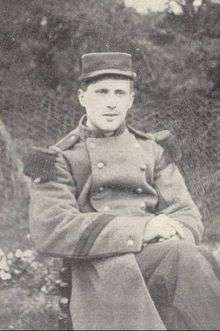Jules-André Peugeot
Jules-André Peugeot (French: [pøʒo]; June 11, 1893 – August 2, 1914) was the first French soldier to die in World War I. He died one day before war was formally declared on France by Germany, in the same skirmish in which Albert Mayer became the first German soldier to die.
Jules-André Peugeot | |
|---|---|
 | |
| Born | June 11, 1893 Etupes, France |
| Died | August 2, 1914 (aged 21)[1] Joncherey, France |
| Buried | |
| Allegiance | France |
| Service/ | French Army |
| Years of service | 1913–1914 |
| Rank | Corporal |
| Unit | 14th Infantry Division, 27th Infantry Brigade, 44th Regiment, 6th Company |
| Battles/wars | Skirmish at Joncherey |
Early life
Before being called up for compulsory military service in 1913, Jules Andre Peugeot was a teacher.
Death
On mid morning on August 2, 1914, a German cavalry patrol led by Leutnant Albert Mayer patrolled into France before war had been officially declared. Upon crossing into French territory Albert Mayer slashed a French sentry with his saber before going deeper into France.
Around 9:30 Peugeot and his fellow soldiers were eating breakfast in a billet house owned by a certain M. Doucourt. The owner of the house's daughter, Nicolet, came in and told the soldiers that a German patrol had entered the town at which Peugeot and his comrades arose from breakfast to meet them. At 9:59 Peugeot yelled at Mayer and his patrol to stop, as they were under arrest, but Mayer pulled out a pistol and shot Peugeot in the shoulder. Peugeot stumbled and shot his pistol, missing Mayer, but Peugeot's comrades returned fire, hitting Mayer in the stomach and head, killing him. Peugeot went back to the billet house where at 10:37 am he died on the steps of the house.
See also
- Albert Mayer (soldier), the first soldier and first Imperial German Army soldier killed, 1914
- John Parr, the first British Army soldier killed, 1914
- Thomas Enright, one of the first three American Army soldiers killed, 1917
- Merle Hay, one of the first three American Army soldiers killed, 1917
- James Bethel Gresham, one of the first three American Army soldiers killed, 1917
- George Edwin Ellison, the last British Army soldier killed in World War I, at 9:30 a.m. 11 November
- Augustin Trébuchon, last French soldier killed, at 10:45 a.m. 11 November
- George Lawrence Price, last Commonwealth soldier killed in World War I, 10:58 a.m. 11 November.
- Henry Gunther, last soldier killed in World War I, at 10:59 a.m. 11 November.
References
- Jordan, Daniel (11 March 1916). "First to fall for France" (PDF). The New York Times. Retrieved 18 April 2012.